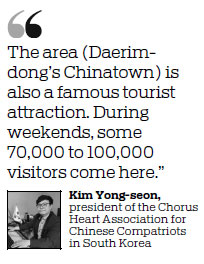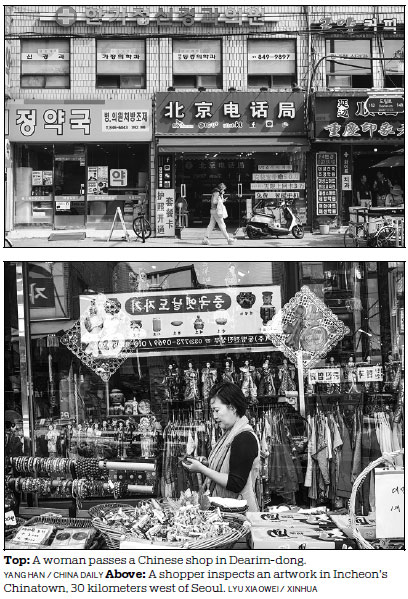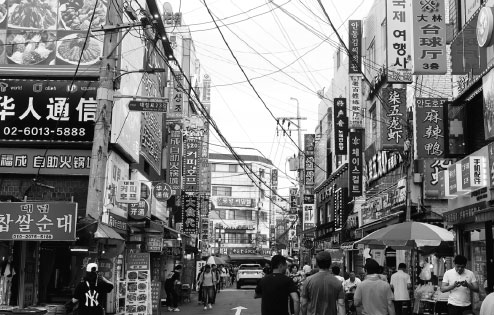Business thrives in Seoul's unofficial Chinatown
Area finds the right ingredients for success
In Daerim-dong, Seoul's unofficial Chinatown, it is not unusual to hear people switching between Korean and Mandarin, as the neighborhood is home to one of the highest concentrations of Chinese in the South Korean capital.

Unlike many places in Seoul that are lined with coffee shops, the area is home to Chinese cuisine - from hotpot, Peking duck and lamb skewers to spicy crayfish and even marinated pork snout.
The ingredients, including spices used in Chinese food, can be found at an array of supermarkets and the Central Market.
A first-time visitor to the area, South Korean Kim You-kyong, 25, said she hoped to find a restaurant serving spicy crayfish - a much-loved summer dish in China.
"I know the area is often dubbed 'a small China in South Korea', so I want to try authentic Chinese food that can only be found here," Kim said.
Daerim-dong is home to about 30,000 Chinese nationals, 90 percent of whom are ethnic Koreans, said Kim Yong-seon, president of the Chorus Heart Association for Chinese Compatriots in South Korea. "Any Chinese, whether ethnic Koreans or not, can find everything they need here, be it food, visas, academic arrangements or even jobs," he said.
His association is one of the largest of its kind. The term" Chinese compatriot" is often used by South Koreans when referring to ethnic Koreans from China.
In January, he established the Global Center for Entrepreneurship to encourage and help ethnic Koreans from China, as well as other foreigners, explore business opportunities in South Korea.
There were more than 2.41 million foreigners living in South Korea as of the end of June, nearly 45 percent of them being Chinese citizens, according to the South Korean Ministry of Justice. Ethnic Koreans with foreign nationalities account for nearly 37 percent of the expatriates in the country, with 82.5 percent of them coming from China.
Kim Yong-seon, who is also president of the South Korea-China Trade Association, said that over the past decade, lower rents in Daerim-dong in southwestern Seoul and the nearby Garibong-dong area have attracted Chinese migrants seeking better-paid jobs.
A computer engineer, surnamed Park, said: "I've never seen so many signs in Chinese elsewhere in Seoul. I think this place is quite special."
Park, 57, was visiting Daerim-dong to celebrate his last day at work before retirement. He said he had never been to the area before, but it was recommended by his junior colleagues for its famed malatang, a spicy soup-based dish with assorted vegetables and meat that originated in Sichuan province. It is popular throughout China and South Korea.
In June, the Korea Joong-Ang Daily reported that the growing demand for malatang could be one of the reasons that in recent years some of the bestselling foreign beers in South Korea have come from China.
Last June, Nana, 25, an ethnic Mongolian from North China's Inner Mongolia autonomous region, married an ethnic Korean and arrived in South Korea for the first time to take care of her mother-in-law. To support the family, she works as a part-time waitress at a restaurant in Daerim-dong's Chinatown, together with her husband and aunt.
The restaurant offers a wide range of Chinese dishes, from spicy cumin barbecue to braised chicken with potato, and sweet and sour spare ribs. During Dragon Boat Festival in June, Nana said they also made zongzi - pyramid-shaped glutinous rice dumplings wrapped in reed leaves.
In addition to dine-in or takeout options for traditional Chinese dishes, some visitors from other parts of South Korea even ask the restaurant to help arrange express deliveries.
"The streets are often full of crowds during weekends. The majority of visitors are Chinese, but there are also many locals," Nana said, adding that more than 40 percent of customers at her restaurant are Korean.
South Korea's official Chinatown is in the port city of Incheon. Since the early 2000s, the city government has invested $6.3 million to revive the area that was home to the first Chinese settlers, mainly from Shandong province, back in the late 19th century.
Situated about 30 kilometers west of Seoul, Incheon's Chinatown is dotted with Chinese-style buildings, and is known as the birthplace of jajangmyeon (fried sauce noodles), a localized Chinese dish served millions of times each day nationwide.
But Kim Yong-seon, from the ethnic Koreans association, said that although the area caters to tourists, fewer than 1,000 Chinese probably still live there. On the other hand, Daerim-dong's Chinatown has not been planned.
Soon-hyung, 48, a rice cake shop owner who has worked in Daerim-dong for 10 years, has witnessed changes in the area.
"Now you can see Chinese restaurants everywhere (in Daerim-dong)," said Soon-hyung, who chose not to give his family name. He said rents have doubled in recent years.
In 2006, a report on revitalizing Chinatowns by the Federation of Korean Industries, or KFI, said the economic benefits of setting up such areas in large cities, including Seoul, could reach nearly 24 trillion won ($19.8 billion), attracting foreign investment and generating consumption. It would also create 920,000 new jobs.
A major part of this potential may relate to tourism. With Chinese making nearly 150 million outbound visits last year, the country is the world's biggest outbound tourism market, according to a report by the China Tourism Academy and online travel agency Ctrip.
The KFI report highlighted this potential, noting that Asian countries have been working to attract Chinese tourists. Moreover, major cities around the world, including Bangkok, Singapore, Chicago, New York and Vancouver, have all established sizable Chinatowns.
The results can be impressive. For example, Yokohama's Chinatown in Japan, reputedly the largest in Asia, attracts more than 18 million visitors a year, surpassing the annual attendance at Tokyo Disneyland in Japan.
Meanwhile, the Chinatown in Vancouver, Canada, with its spacious shopping malls and a traditional Chinese-style park, has become a popular tourism venue attracting about 15 million visitors a year, according to the KFI report.
Like its overseas counterparts, Daerim-dong's Chinatown is also attracting plenty of attention.
Kim Yong-seon, from the South Korea-China Trade Association, said: "The area is also a famous tourist attraction. During weekends, some 70,000 to 100,000 visitors come here."
kelly@chinadailyapac.com

|
Billboards in Chinese and Korean hang from buildings in Daerim-dong, Seoul, South Korea.Yang Han/china Daily |
(China Daily Global 09/18/2019 page2)



















